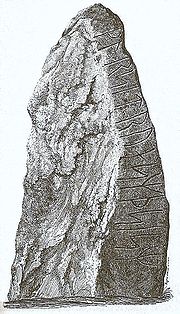
Istaby Runestone
Encyclopedia

Rundata
The Scandinavian Runic-text Data Base is a project involving the creation and maintenance of a database of runic inscriptions. The project's goal is to comprehensively catalog runestones in a machine-readable way for future research...
catalog as DR 359, is a runestone with an inscription in Proto-Norse which was raised in Istaby, Blekinge
Blekinge
' is one of the traditional provinces of Sweden , situated in the south of the country. It borders Småland, Scania and the Baltic Sea.The name "Blekinge" comes from the adjective bleke, which corresponds to the nautical term for "dead calm"....
, Sweden
Sweden
Sweden , officially the Kingdom of Sweden , is a Nordic country on the Scandinavian Peninsula in Northern Europe. Sweden borders with Norway and Finland and is connected to Denmark by a bridge-tunnel across the Öresund....
, during the Vendel era
Vendel era
In Swedish prehistory, the Vendel era is the name given to a part of the Germanic Iron Age ....
.
Transliteration into Latin characters
- AP Afatz hAriwulafa ¶ hAþuwulafz hAeruwulafiz
- AQ hAþuwulafz hAeruwulafiz ¶ Afatz hAriwulafa
- B warAit runAz þAiAz
Transcription into Proto-Norse
- AP Aftr Hariwulfa. Haþuwulfz Heruwulfiz
- AQ Haþuwulfz Heruwulfiz aftr Hariwulfa
- B wrait runaz þaiaz.
English translation
- AP In memory of Hariwulfar. Haþuwulfar, Heruwulfar's son,
- AQ Haþuwulf(a)r, Heruwulfar's son, in memory of Hariwulfar
- B wrote these runes.
Interpretation
The Istaby, Stentoften RunestoneStentoften Runestone
The Stentoften Runestone, listed in the Rundata catalog as DR 357, is a runestone which contains a curse in Proto-Norse that was discovered in Stentoften, Blekinge, Sweden....
and Gummarp Runestone
Gummarp Runestone
The Gummarp Runestone, designated as DR 358, was a runestone from the Vendel era and which was located in the former village of Gummarp in the province of Blekinge, Sweden.-Description:...
inscriptions can be identified with the same clan through the names that are mentioned on them. The names have alliterative
Alliteration
In language, alliteration refers to the repetition of a particular sound in the first syllables of Three or more words or phrases. Alliteration has historically developed largely through poetry, in which it more narrowly refers to the repetition of a consonant in any syllables that, according to...
first name element combined with a lycophoric second element that represent an aristocratic naming tradition common among chieftains. The Björketorp Runestone
Björketorp Runestone
The Björketorp Runestone in Blekinge, Sweden, is part of a grave field which includes menhirs, both solitary and forming stone circles....
lacks names and is raised some tens of kilometers from the others. However, it is beyond doubt that the Björketorp runestone is connected to them, because in addition to the special runic forms, the same message is given on the Stentoften Runestone. Of these, on stylistics grounds, the Istaby runestone may be the oldest.
The name Hariwulfa is a combination of hari meaning "warrior" and wulafa "wolf," while the haþu of Haþuwulfz means "battle" and the heru of Heruwulfar, when combined in personal names, means "sword." The latter name also has a suffix indicating paternal decent, so the name Heruwulfar in full means "of the family of Sword-Wolf." A shortened form of the name Hariwulfa survived into the Viking Age
Viking Age
Viking Age is the term for the period in European history, especially Northern European and Scandinavian history, spanning the late 8th to 11th centuries. Scandinavian Vikings explored Europe by its oceans and rivers through trade and warfare. The Vikings also reached Iceland, Greenland,...
and is attested in the inscription on the Hærulf Runestone
Hærulf Runestone
The Hærulf Runestone is a Viking Age runestone located north of Hovslund's station in Southern Jutland, Denmark.-Description:The Hærulf Runestone dates from the 10th century and is classified as being carved in runestone style RAK. This is the classification for inscriptions with runic bands that...
. It has been suggested that the assignment of such lycophoric names is related to ritualistic practices and religious wolf-symbolism used in the initiation of young warriors.
The Istaby runestone is currently located at the Swedish Museum of National Antiquities
Swedish Museum of National Antiquities
Swedish Museum of National Antiquities is a museum located in Stockholm, Sweden that covers Swedish cultural history and art from the Stone Age to the 16th century...
in Stockholm
Stockholm
Stockholm is the capital and the largest city of Sweden and constitutes the most populated urban area in Scandinavia. Stockholm is the most populous city in Sweden, with a population of 851,155 in the municipality , 1.37 million in the urban area , and around 2.1 million in the metropolitan area...
. The stone has a Danish Rundata catalog number as Blekinge was part of the historic Denmark.
Sources
- Jacobsen, Lis & Moltke, ErikErik MoltkeErik Moltke was a runologist, writer, editor. Through his leadership the Runologist Section of the National Museum of Denmark became a world centre for the scientific study of runology c.1942 CE....
: Danmarks Runeindskrifter. 3rd tome. 1941.
External links
- Photograph of stone in 1999 - Swedish National Heritage Board

